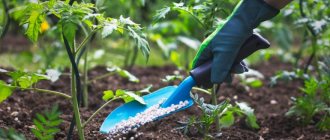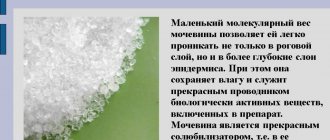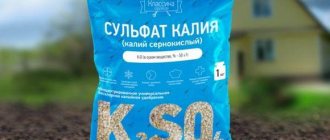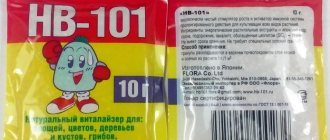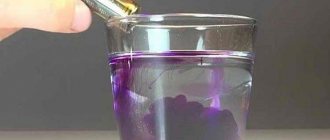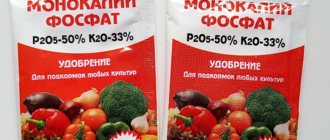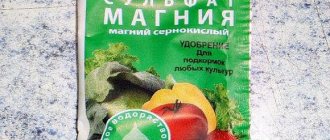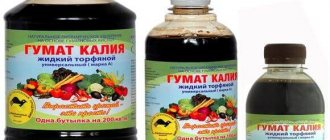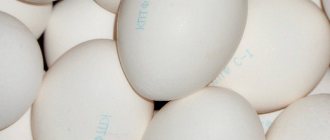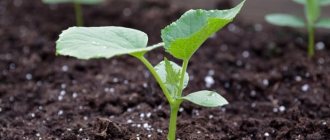Category: Mineral fertilizers Reading time: 9 min · Views: 18,507
Ammonium nitrate is used in 80% of large agricultural farms. This demand is due to the fact that the fertilizer has a beneficial effect on plants even in cold weather and when the soil is severely frozen. Ammonium nitrate is a universal fertilizer that is suitable for almost all plants in agriculture.
Ammonium nitrate: properties of fertilizer
Main properties of ammonium nitrate:
- high efficiency of the drug - its consumption per 1 hectare of garden area is no more than 1 kg;
- if an excessive amount of lime was added to the soil, this saltpeter will acidify the soil;
- the substance dissolves perfectly in water without forming sediment;
- Ammonium nitrate contains nitrogen in two forms - with a rapid dissolution period and an extended one;
- the temperature characteristics of the soil do not affect the absorption of nitrogen by the root system of plants, so this preparation can be applied immediately after the snow melts;
- Almost all applied fertilizer is absorbed by the plant, its losses in the soil are minimal, so it does not need to be embedded into the soil to a depth.
Description of fertilizer - video
In addition, the cost of ammonium nitrate is not too high compared to most fertilizers, which makes the drug very attractive to farmers.
But you should remember some of the disadvantages of this drug:
- it cannot be used as a foliar fertilizer, since the ammonium nitrate solution severely burns the foliage even in a small concentration;
- This fertilizer cannot be applied to acidic soil;
- Failure to comply with the dosage and exceeding it lead to burns of the root system; fertilizing should be done after watering or rain.
Photo of ammonium nitrate - what the fertilizer looks like
Fertilizing should be applied according to the schedule - for most vegetable plants, a single application of ammonium nitrate per season is sufficient
. Instead, you need to add drugs containing potassium and phosphorus.
Ammonium nitrate is a very strong fertilizer; exceeding its dosage when applied to the soil can lead to an increase in the amount of nitrates in fruits
. However, nitrates can be washed out of the soil by heavy watering or during rainy periods.
Storage of ammonium nitrate
It is necessary to store the fertilizer in an airtight container so that the nitrogen does not evaporate and the fertilizer does not lose its positive properties.
The storage place should be dry, well ventilated, the temperature should not exceed 30 degrees. No flammable materials should be located nearby. Sudden changes in temperature should be avoided to avoid the process of recrystallization . It is also necessary to prevent direct exposure to sunlight (when heated, ammonium nitrate can involuntarily explode).
The people who work most successfully in vegetable growing are those who love nature, have a special vision for the most insignificant changes in the life of plants, know how to evenly distribute physical activity, and patiently do their work.
You must be able to loosen the soil, weed the plantings, add soil, work with fertilizers, and prepare vegetable seeds for sowing. Then sow them with vegetable seeders or by hand and lime the soil.
Hygroscopicity of ammonium nitrate.
Also, do not forget about the property of hygroscopicity. Granules perfectly absorb moisture, so it is important to maintain a loose consistency of the substance. To do this, we store the fertilizer exclusively in dry rooms, additionally placing moisture-resistant substances in bags with saltpeter.
Explosiveness of ammonium nitrate.
The most important thing to remember is that saltpeter is explosive. Therefore, it is necessary to remove all flammable materials, petroleum products, and wood from the room where the fertilizer is stored. In addition, you should not smoke or allow open flames nearby. The safe distance from walls to fertilizer packages is twenty centimeters, and from packages to heat sources - at least one and a half meters.
The importance of temperature.
Make sure that the temperature in the storage room does not rise above thirty-two degrees, otherwise the saltpeter may explode. Good ventilation is a must. Sudden changes in temperature should also be avoided, otherwise ammonium nitrate will recrystallize and the granules will become difficult to dissolve.
Ammonium nitrate - formula and composition of fertilizer
This substance is a white powder or granules with a yellowish tint. Granulated ammonium nitrate has the same properties as powder, but decomposes a little more slowly in the soil.
This drug has other names:
- nitric acid salt;
- Ammonium nitrate.
Ammonium nitrate formula: NH4NO3
. Some manufacturers add sulfur to its composition, which is also required by cultivated plants for active growth. The percentage of this trace element in ammonium nitrate is up to 13%.
Table:
There are several varieties of this drug, depending on the additional elements included in its composition:
- Indian saltpeter
- in addition to active nitrogen, it also contains potassium. As a result, this fertilizer, when applied to the soil, simultaneously promotes the growth of vegetative mass by the plant, and also prepares it for active budding and ripening of fruits. - Norwegian
- it contains carbonate (like lime), magnesium and potassium. During the production process of the drug, its granules are exposed to petroleum products, which break down for a long time in the soil. As a result, nutrients are supplied to the soil in portions over a long period. - Ammonium nitrate B
, which contains nitrogen, sulfur, magnesium, calcium, potassium. - Magnesium
, in this preparation magnesium ions are part of the crystal lattice of the substance. - Ammoniated calcium nitrate
. This fertilizer can be applied to almost all cultivated plants, fruit trees and shrubs. The drug prevents soils from acidifying, maintaining their neutral or slightly acidic reaction.
What it is?
Ammonium nitrate is a mineral fertilizer based on nitrogen (26% to 34.4%) and sulfur (3-14%). Nitrate has other names: ammonium nitric, ammonium nitrate, ammonium salt of nitric acid.
Fertilizers with a sulfur component are especially well absorbed by plants. Sulfur in this tandem acts as a corrector , because in itself it is not a nutritional element for garden crops.
Formula: NH4+. Chemical composition: nitrates, metals, ammonium with a positive ion charge.
Composition of ammonium nitrate
Fertilizer belongs to the group of preparations with a high nitrogen content. From a chemical point of view, it is ammonium nitrate. Ammonium nitrate granules consist of 34% nitrogen. The chemical composition of the drug does not allow it to be stored together with such materials as:
- Peat;
- Sawdust;
- Lime;
- Organic substances.
Their presence can provoke spontaneous combustion. Nitrate can be mixed with potassium and phosphate fertilizers, but mixing can only be done before adding the preparations to the soil.
Receipt
Ammonium nitrate is obtained by neutralizing nitric acid with ammonia gas:
HNO3 + NH3 (gas) → NH4NO3 + 144.9 kJ
The resulting solution of ammonium nitrate is evaporated, subjected to crystallization and finally dried. Various impurities are added to the resulting substance to improve its physical and chemical properties.
Physical and chemical properties
Ammonium nitrate (without impurities)
– a white crystalline, very hygroscopic substance, in the open air it becomes damp and cakes. Depending on temperature conditions, there are five crystalline modifications that can transform into each other only when the ambient temperature changes.
The fourth and fifth modifications are of practical importance, existing within the following limits:
- IV – from +32.2 to –16.9°C;
- V – below –16.9°C.
When transitioning from one modification to another, the substance recrystallizes with a change in volume, and the substance becomes highly compacted.
Density of modification IV is 1.725 g/cm3.
Ammonium nitrate dissolves well in water and other substances:
- Solubility in water: at 0°C – 119 g per 100 g,
- at +25°C – 212 g per 100 g,
- at +50°C – 346 g per 100 g.
Ammonium nitrate (fertilizer)
- a granular substance with much less hygroscopicity. Granule size is 1–4 mm. The fertilizer contains various additives to reduce caking. Condensing substances can be finely ground phosphate rock, gypsum, kaolinite, magnesium nitrate, etc. These additives give the fertilizer a yellowish tint. Fixin, administered as an additive, gives it a reddish color.
Ammonium nitrate (fertilizer) meets the following requirements:
- nitrogen content in dry matter – not less than 34%;
- water content – no more than 0.2–0.3%;
- acidity of a 10% aqueous solution – 4–5%;
- statistical strength of granules – 5–7 N/granule;
- friability – not less than 100%.
Ammonium nitrate (fertilizer) is an oxidizing agent. Fire hazardous. At a temperature of 210 °C and interaction with sulfur, sulfur pyrites, acids, superphosphate, bleach and powdered metals, it decomposes, releasing toxic oxides of nitrogen and oxygen.
Ammonium nitrate application rate
In the spring, ammonium nitrate in powdered or granular form can be added to the planted seedlings of any vegetable crops.
, 5-10 g of the drug should be used per square area. Typically, fertilizer is applied 12-15 days after transplanting seedlings into open ground, or 18-21 days after sprouts appear.
Before planting root crops in the prepared beds, pour up to 30 g of the drug per square area
. If the soil is severely depleted, then the dose of ammonium nitrate should be increased to 50 g per 1 m2.
For fruit bushes, the dosage of applying nitric acid salt is up to 18 g per 1 m2
. The fertilizer is scattered around the tree trunk after digging.
Fertilizer application rates for various crops of ammonium nitrate - video
To feed fruit trees, 24-28 g of the drug is diluted in a bucket of water and poured into the tree trunk in the spring after flowering.
. After about a month, fruit trees are re-fertilized with this fertilizer.
Important!
After plants or fruit trees and shrubs have been fed with ammonium nitrate solution, they should be watered with plain water so that the root system does not burn.
Recommendations for dosage and proportions
Unlike many other fertilizers, saltpeter acts immediately. Farmers get the greatest effect from early spring to mid-summer, while greenery is actively forming. The basic rule is to apply fertilizer to the depressions and cover them with soil to protect them from washing out. To distribute the composition in the soil, it is loosened. Recommended proportions:
- seedlings - up to 6 g of granules are consumed per hole. You can dilute the composition with water at the rate of 40 g per 10 l;
- vegetables - up to 20 g of fertilizer per 1 sq. m. Pour into the holes 21 days after emergence;
- garden trees - up to 20 g of saltpeter per 1 sq. m of soil around the trunk.
Nitrate is of particular benefit to potatoes, white cabbage, onions, grapes, strawberries, currant and gooseberry bushes, and flowers on the site. Dosage recommendations for specific crops can be found in other articles on the site.
The use of ammonium nitrate in the garden
Ammonium nitrate
– one of the most popular fertilizers among gardeners and gardeners in the spring and early summer, which is used to ensure that cultivated plants actively increase their vegetative mass.
In summer and autumn, nitrogen-containing fertilizers (including ammonium nitrate) should not be applied to the soil.
In this case, plants and trees will only grow green mass, stems and shoots. Shoots and branches on trees and shrubs that grow in mid- and late summer do not have time to become woody before the cold weather begins and simply freeze out in winter.
Below we will describe for which vegetable and garden crops ammonium nitrate is used.
Application of ammonium nitrate - video
Ammonium nitrate for vegetable seedlings
Ammonium nitrate is rarely used to feed vegetable seedlings. Most often, liquid organic fertilizers and urea are applied to seedlings (with an interval of 10-12 days).
But, for example, ammonium nitrate is necessarily used to feed tomato seedlings. For the first time, these seedlings are fertilized with a solution of mullein, and after 12-14 days you can add a solution of nitrate, diluting 15-20 g of the drug in a bucket of water. This amount of solution is used to apply 3 m2 of crops.
Ammonium nitrate for tomatoes
Nitrogen is needed by young tomato bushes so that they actively grow green mass and strengthen the stems
. Ammonium nitrate contains about 34% of this macroelement, so it can be used as the main fertilizer in the spring, as well as as part of a complex fertilizer in combination with potassium salt and superphosphate.
Ammonium nitrate is also added to planting holes (1 tbsp) when planting tomatoes in a permanent place. Also, 5 g of this nitrogen fertilizer is sprinkled on each m2 during the period of active flowering.
The use of ammonium nitrate for cucumbers
Ammonium nitrate is added to the soil before planting cucumber seeds or their seedlings in a permanent place in the garden. It should be buried about 8-10 cm into the soil for spring digging. Many vegetable growers simply scatter this fertilizer around the garden during the period of massive snow melting.
During the period of growth of cucumber vines before flowering, you can water them with a solution of ammonium nitrate, diluting 15-20 g of the drug in a bucket of water.
It is important to know!
However, experts warn that this crop actively accumulates nitrates in its fruits, so ammonium nitrate should be applied under it with great caution and in no case exceed the doses specified in the instructions for use.
Ammonium nitrate for potatoes
Before planting potato tubers in holes, add 1 tbsp. l. Ammonium nitrate. Subsequently, after 18-20 days, the dry preparation should be scattered over the area at the rate of 5 g per square area.
Fertilizing potatoes with ammonium nitrate - video
Fertilizing strawberries with ammonium nitrate
Before planting strawberries in a permanent place, compost or humus is added to the prepared beds at the rate of at least 5 kg per 1 m2. In the first year after planting this berry crop, it is not recommended to apply nitrogen-containing fertilizers, because they provoke rotting of the strawberry bushes.
Starting from the second season in the spring, ammonium nitrate should be added to strawberry beds.
. The application rate of the drug is 100 g per 1 m2 of area. Trenches 10 cm deep are dug along the rows, into which nitrogen fertilizer is poured in an even layer, the furrows are leveled with a rake and watering is carried out.
Next season, strawberries are fertilized with complex fertilizer, which contains per 10 m2:
- phosphorus – 100 g;
- potassium salt – 100 g;
- ammonium nitrate – 110-140 g.
This composition is applied to the beds during the period of green mass appearance, as well as after harvesting ripe fruits.
Instead of dry fertilizer in the spring, you can fertilize with ammonium nitrate solution
. To do this, dilute up to 30 g of fertilizer in a bucket of water and carefully water the bushes strictly at the root.
Ammonium nitrate for root vegetables: beets, carrots, etc.
When preparing beds for planting root crop seeds, ammonium nitrate is applied to the furrows that are made between the rows. This fertilizer is added to them in dry form.
Ammonium nitrate for fruit trees: apple, pear, plum, apricot, peach and others
In the spring, when the snow has completely melted, it is time to feed all fruit trees and shrubs.
. During this period, cultivated plants in the garden need fertilizers containing nitrogen.
Nitrogen nitrate should be applied to the tree trunks of fruit trees several times during the summer.
.
Prepare the solution as follows: dissolve up to 30 g of the drug in a bucket of water. This proportion is the most optimal and saturates the soil with a sufficient amount of nitrogen. Watering with ammonium nitrate is carried out strictly in the tree trunk circles, preventing the drug from getting on the bark and vegetative mass of the trees.
Fruit trees are fertilized at least 3 times per season with an interval of 18-20 days.
Description of fruit tree varieties!
Apricot Northern Triumph Plum Study Apricot Royal Peach Redhaven
Fertilizing berry bushes with ammonium nitrate (raspberries, honeysuckle, currants, blackberries, gooseberries)
You can also apply this preparation to fruit bushes several times a season, but strictly “at the root.”
. For gooseberry and currant bushes up to 3 years old, the rate of application of this fertilizer is up to 30 g per square. During the period of active ripening of berries, the consumption of ammonium nitrate should be up to 50 g.
Spring feeding of these shrubs with ammonium nitrate can be carried out even in the snow.
But it is better to carry it out after the snow has melted, and bury the fertilizer into the soil to a depth of 9-11 cm.
Fertilizing garlic with ammonium nitrate
Garlic, like many other root vegetables, really needs nitrogen, which promotes the active germination of cloves.
Fertilizing garlic in spring using ammonium nitrate - video
Ammonium nitrate is applied to the beds with garlic in the spring at the rate of 1 tbsp. l. drug per square area. Or you can prepare a solution of ammonium nitrate according to the instructions for use (up to 30 g per bucket of water). Fertilizing garlic with ammonium nitrate in the spring is carried out in the snow.
You can also apply this fertilizer under garlic in the fall - before the onset of cold weather.
Ammonium nitrate for flowers
Ammonium nitrate is also actively used in gardening, adding it in the spring in order to stimulate foliage growth.
For perennials, granules of the drug are applied during the snow melting period - in this case, the fertilizer reaches the roots faster along with the melted snow. In this case, additional watering of the plants is not required - due to the large amount of melt water, the flower roots will not be burned by the preparation.
In mid-spring, when the flowers begin to actively grow, it is better to feed them with a solution of ammonium nitrate (up to 2 tablespoons per bucket of water), in this case the nutrients will flow to the roots evenly.
When the first buds appear on flowering plants, fertilizing with ammonium nitrate is stopped, otherwise the vegetative mass of these crops will continue to increase to the detriment of flowering. Because of this, aphids may appear more actively on the bushes.
FUNGICIDES for the GARDEN AND VEGETABLE VEGETABLE!
Bordeaux mixture Fungicide Antracol
Ammonium nitrate for roses
“Queens of flowers” require ammonium nitrate no less than other cultivated plants during the period of active growth. Therefore, this fertilizer with a large amount of nitrogen is applied for the first time at the end of April or beginning of May after the spring sanitary pruning of the bushes has been carried out.
Varieties of beautiful roses!
Rose Gloria Day climbing Rose floribunda climbing Rumba Yellow rose floribunda Arthur Bell
To do this, dilute this drug in a bucket of water (the norm is 1 tbsp.). Other fertilizers should be added to this solution - superphosphate and any potassium salt. Approximately 6 liters of this liquid fertilizer is applied to each plant.
. These complex fertilizers first of all activate the growth of roots, which will serve as an impetus for the start of sap flow.
After 2-3 weeks, similar feeding should be repeated in order to activate the appearance of buds
. After the first flowers begin to appear on the rose bushes, ammonium nitrate is no longer added, otherwise the vegetative mass, including young shoots, will continue to grow, and flowering will be inactive (or buds will not appear at all).
Ammonium nitrate for lawn
After winter, the lawn grass does not look very attractive - some freezes, some dried grass remains, and there is very little fresh greenery. But after a month and a half, young greenery comes from the roots. And all dried and frozen grass should be removed during spring cleaning in the garden.
To activate the growth of green mass, it is recommended to add ammonium nitrate to the lawn.
. The consumption of this granular fertilizer is no more than 40 g per 1 m2. All granules are evenly distributed over the surface of the earth, then abundant watering is carried out.
Important!
You cannot increase the dosage of the drug, otherwise you can burn all the roots of the lawn grass.
The use of ammonium nitrate for indoor plants
Not every indoor plant needs to be fertilized with ammonium nitrate, so in each specific case, before applying this drug, you need to read the literature about what specific fertilizers your flowers need.
This nitrogen fertilizer is best suited for long-growing indoor plants - palm trees, ferns, as well as other ornamental crops, the main advantage of which is foliage
. After all, the main property of nitrogen is the ability to give impetus to the development of the above-ground parts of plants (shoots, foliage).
Usually, all fertilizers for indoor flowers are applied in liquid form, and saltpeter is no exception.
. Usually no more than 2 tbsp is diluted in a bucket of water. l. Saltpeter, and for each plant an amount of liquid fertilizer is applied, proportional to the capacity of the pot or flowerpot.
Foliar feeding with ammonium nitrate
Foliar feeding of any vegetable plants, flowers (including indoor flowers), fruit trees and shrubs is usually not carried out, since the solution of this drug is quite concentrated and causes burns to the leaf blades
. Because of this, plants get sick for a long time and often die.
Some summer residents still carry out leaf feeding of some cultivated plants, but the amount of ammonium nitrate in the solution should not be more than 0.25 g per 1 liter of water. In a private household, it is extremely difficult to measure such an amount of the drug.
Nitrogen fertilizers for the garden - video
Fertilizing with ammonium nitrate
Fertilizing of fruit trees, flowers, roses, lawns and indoor flowers is also carried out carefully, avoiding exceeding the dosage of this drug. Fruit trees and shrubs have the ability to accumulate nitrates in ripening fruits, which negatively affects human health.
The best fertilizers for the vegetable garden!
Epin Extra Potassium Nitrate Superphosphate Potassium Monophosphate
The use of ammonium nitrate in gardening allows you to increase the volume of vegetative mass, improves flowering and fruiting, but strict adherence to the rate of application of the drug to the soil is required.
What types of saltpeter are there?
Let us consider in detail the types of saltpeter, their purpose and methods of application.
Ammonia
Ammonium nitrate (NH4NO3) is a nitrate nitrogen fertilizer. Synonymous names are ammonium nitrate or ammonium nitrate.
The chemical compound was discovered by the German chemist and physician I. Glauber in the mid-17th century.
The main purpose is pre-sowing and early fertilizing of vegetable crops.
Available in granular form. The granules are concentrated, compressed, white in color, but may have a yellowish or red tint due to additives. Packaging varies depending on the purpose and scope of application, area of the site. In specialized stores it is sold in bags of 10-50 kg, in plastic bags of 1-5 kg.
Compound:
- total nitrogen 33-34%;
- oxygen 60%;
- hydrogen 5%.
In addition, nitrogen:
- affects the production and amount of protein in roots and fruits;
- accelerates fruiting and growth processes;
- increases productivity by 2-3 times;
- is an obligatory component of basic proteins, nucleic acids, enzymes;
- directly involved in cellular metabolism and energy.
Spectrum of action (for which plants it is intended):
- cereals (rye, wheat);
- garden trees (cherry, apple, pear, apricot);
- berry bushes (raspberries, blackberries, black currants);
- vegetables and root vegetables - only in moderate concentration through watering;
- It is not recommended to fertilize melons (watermelons, melons, cucumbers, squash).
Features of ammonium nitrate - it is a chemically neutral, but physiologically acidic fertilizer. The soil naturally acidifies.
To remove the acidifying effect, lime or chalk is added to the soil at the same time. The amount of chalk should be small, in a ratio of 1:5 from ammonium nitrate.
Preparation of master batch:
- 1 tbsp. l. ammonium nitrate;
- 1/5 tbsp. l. chalk (lime);
- dissolve in 8-10 liters of warm water.
Fertilizer dosage – 1 tbsp. l. for 10 l.
Consumption - 1 liter of prepared mixture per 1-2 plants, depending on nutritional needs. Average costs for the area of the plot are 1-2 buckets (20 liters of solution) per 1 sq. m. m.
In dry form, ammonium nitrate is embedded in the soil under fruit trees and shrubs to a depth of 15-20 cm. Consumption - up to 20 g per 1 sq. m. m.
In the active phase before flowering, garden crops (cucumber, zucchini, squash) experience a high need for fertilizing. Experienced farmers do not recommend increasing the concentration of the solution. The watering dosage is doubled.
The main rule is to apply fertilizing not into dry soil, but over damp, spilled soil, so as not to cause burns to the roots.
Potassium
Potassium nitrate (KNO3) is a potassium supplement with a high content of nitrogen compounds.
These are water-soluble colorless (translucent) crystals. Inorganic elements melt at temperatures above 34-35 degrees. C. There is no specific odor, the crystals are hygroscopic (fertilizer cakes if stored improperly and with excessive air humidity).
Active composition:
- more than 13% nitrogen;
- up to 45-46% potassium - the main active ingredient.
Functions of potassium:
- responsible for plant metabolic processes;
- regulates the growth and full ripening of fruits;
- seed germination stimulator,
- strengthens seedlings, protects seedlings from pathogenic zones.
Potassium nitrate is used for fruit and vegetable plants:
- fruit trees and berries (apple, pear, raspberry, strawberry, currant);
- decorative and potted flowers (crystals are scattered dry or mixed with ash in a ratio of 1:2);
- vegetables (cucumbers, tomatoes, carrots, beets).
The mother liquor is prepared in a ratio of 15-20 g (matchbox without a slide) per bucket of water - 9-10 liters.
Features and “zone” of action of potassium nitrate:
- strengthens the roots of vegetable seedlings;
- accelerates the process of photosynthesis;
- increases productivity by 1.5-2 times;
- has no contraindications for any type of soil;
- especially useful for loams and peaty substrates;
- In addition to open ground, they are used in greenhouses, greenhouses, and home floriculture.
Nutrient fertilizing is applied through watering every ten days of the month, starting in May (as soon as the ovary appears on cucumbers and tomatoes). Mixing with organic matter is dangerous.
To treat leaves, use a solution in a ratio of 8 g per 9-10 liters of water.
Calcium
Calcium nitrate is a salt (of inorganic origin) of nitric acid, formula – Ca(NO3)2. Physiologically, alkaline fertilizer is also called calcium nitrate, calcium nitrate.
Physical characteristics - anhydrous salt, transparent crystals with a cubic lattice.
Features of calcium nitrate:
- the only fertilizer that contains completely soluble calcium and a sufficient amount of nitrate nitrogen;
- calcium helps to fully absorb nitrogen compounds;
- can be used on any type of soil, prefers soddy-podzolic soils;
- feeding is suitable for acidified substrate;
- unlike urea, it practically does not acidify the soil;
- calcium nitrate promotes the growth of the aerial part (affects the qualitative formation of cell membranes);
- Pre-sowing fertilizing stimulates the growth of seedlings, the germination of tubers and strengthens the root system.
Fertilizer is produced in granules and powder in various packages and packaged by weight.
Calcined nitrate contains:
- up to 27% nitrogen;
- up to 9% calcium;
- 9% phosphorus;
- up to 0.2% boron, copper, manganese, zinc, cobalt and molybdenum.
Calcium nitrate is most effective on acidic soil. The first feeding of cereal plants is carried out in early spring.
Nutrition required for nightshade crops:
- tomatoes;
- Bulgarian pepper;
- capsicum, chili;
- eggplant;
- black nightshade.
Early application is, first of all, preventive measures against the appearance of blossom end rot (black spots on the surface) of fruits. Putrefactive infections appear when there is a deficiency of calcium in the soil.
When and how to contribute:
- first application - when digging a dry garden, deepen it by 10-15 cm;
- to protect seedlings from diseases, it is recommended to water the plants 10-12 days after planting in open ground;
- the soil is also processed through irrigation in greenhouses and greenhouses;
- stock solution: 2 tbsp. l. for 10-12 liters of water;
- consumption rate: 1 liter in each well;
- fertilizer is applied to moist soil.
The foliar method of fertilizing with nitrogen and potassium is useful for cucumbers and cabbage during the first half of seedling growth.
Spraying is carried out in several stages:
- after the third leaf appears on the sprouts;
- after 7-10 days the procedure is repeated;
- fertilizing stops when active fruiting begins.
Sodium
Sodium nitrate (NaNO3) - sodium nitrate, natural sources - nitronatrite, has a second name - Chilean nitrate.
The chemical compound appears as whitish solid crystals, is found with impurities and has gray and yellow shades. The taste is bitter-salty, the crystals are hygroscopic and odorless.
Active complex of chemicals:
- up to 16% nitrogen;
- 26-28% sodium.
Features of soda nitrate (synonymous name):
- origin: by-product of nitric acid and ammonia;
- 100% soluble in water (faster than potassium nitrate);
- alkaline fertilizing is a strong oxidizing agent;
- neutralizes acidic soils (podzolic, turfy, peaty);
- goes well with phosphorus and potassium water-soluble fertilizers.
Sodium nitrate is beneficial for plants:
- potato;
- tomatoes;
- turnips, radishes;
- rhubarb;
- greens – spinach, celery;
- eggplants, zucchini, squash;
- sugar and table beets;
- garden trees;
- berry bushes;
- decorative flowers.
The main fertilizing is applied to all types of soil in the pre-sowing period - it is incorporated when plowing to a depth of 10-15 cm.
When sowing fodder and table beets, fertilizer is applied in dry form.
Questions from gardeners and gardeners
Below are the most frequently asked questions from readers about this nitrogen fertilizer, along with their answers.
Why is ammonium nitrate needed?
Ammonium nitrate is needed to enrich the soil with nitrogen, which is needed by all cultivated plants in the garden to increase vegetative mass.
What is the chemical formula of ammonium nitrate?
The chemical formula of this drug is NH4NO3.
How much nitrogen is in ammonium nitrate?
This drug contains approximately 34% nitrogen.
Are urea and ammonium nitrate the same thing?
Urea (or carbamide) and ammonium nitrate are completely different fertilizers, the main advantage of which is their high nitrogen content. And if the first preparation contains up to 46% nitrogen, then ammonium nitrate contains only up to 34% of this mineral element.
Urea can be used to apply root and leaf fertilizers, while ammonium nitrate is applied only to the soil.
Urea takes longer to be absorbed by plants, and ammonium nitrate has the ability to be absorbed more quickly by the root system of plants.
Description of urea and ammonium nitrate - pros and cons
What is the price of ammonium nitrate?
The cost of 1 kg of ammonium nitrate is about 13-14 rubles per 1 kg.
What is the composition of ammonium nitrate?
This chemical contains nitrogen, hydrogen, and oxygen. Sulfur, magnesium, potassium, and calcium are often added to ammonium nitrate.
How many grams of ammonium nitrate are in a tablespoon?
One tablespoon contains approximately 13 g of this drug.
How to replace ammonium nitrate for fertilizing?
Ammonium nitrate can be replaced with any other drug containing approximately the same amount of nitrogen in its composition.
How much ammonium nitrate is in a matchbox?
A matchbox can contain no more than 20 g of ammonium nitrate.
Ammonium nitrate or azofoska - which is better?
It is impossible to say unequivocally that one of these fertilizers is better or worse. It’s just that ammonium nitrate contains only easily digestible nitrogen, so it is used only in the spring and early summer.
And azofoska contains all the main components necessary for plants to grow and develop fruits - potassium, phosphorus and nitrogen. Therefore, this fertilizer can be used for application to garden and vegetable crops throughout the spring and summer season.
Where to buy ammonium nitrate?
You can purchase ammonium nitrate in any specialized store, or order it online.
Urea (urea) or ammonium nitrate - which is better?
Urea contains 2 times more digestible nitrogen than ammonium nitrate, so the nutritional properties of 2 kg of urea are equal to 6 kg of ammonium nitrate.
In addition, urea can be used for foliar feeding when plants require urgent nitrogen application, otherwise they may die.
Which is better ammonium nitrate or urea - video
What brands of ammonium nitrate are there?
There are only two brands of this fertilizer: A and B.
What is the hazard class of ammonium nitrate?
This drug is classified as hazard class 5; it does not ignite in direct contact with fire, but can explode - it decomposes at high ambient temperatures and releases oxygen.
Precautions when working with fertilizer
It should be remembered that ammonium nitrate is an explosive substance, it cannot be heated above 32 degrees, so the fertilizer should be stored in cool, well-ventilated areas. For the same reason, saltpeter must not be added to the soil at the same time as peat or sawdust, in which case there is a risk of fire.
Latest articles about gardening
Pruning grapes in spring in a step-by-step video description
Growing gloxinia from seeds at home
How to plant Achimenes rhizomes
Ammonium nitrate - reviews from gardeners and gardeners
Natalya, 55 years old, Kazan: I use this fertilizer to feed my fruit trees in spring and summer. I also apply ammonium nitrate to gooseberries, currants and strawberries, but only in the spring. I buy small packages of this drug and usually use them in one season so as not to leave them for the next year.
Olga, 49 years old, Volgograd: I use ammonium nitrate to feed most vegetable crops and root crops during the spring. As a result, all my plants are green and strong. I am also pleased with the cheap price of this fertilizer.
You can use ammonium nitrate in your garden and garden throughout the spring.
The undeniable advantage of the drug is that it can even be scattered on the snow, and it will be absorbed immediately into the soil, and will not flow away with melt water. The low cost and optimal amount of easily digestible nitrogen in this fertilizer are also advantages of ammonium nitrate.
Recently searched:
Advantages and disadvantages
Knowing all the advantages and disadvantages of urea, you should consider what are the best characteristics of ammonium nitrate.
Advantages of ammonium nitrate:
- Saltpeter can be used from very early spring, when there is still snow, until late autumn with frosts.
- Nitrogen in nitrate is present in two forms, which benefit plants both at the beginning of application and throughout the growing season.
If we consider the disadvantages, the fertilizer cannot be applied to acidic soils. It is also explosive and capable of spontaneous combustion.
Features of application
It is believed that the main share of nitrogen fertilizers (up to 80%) should be applied in the spring months and early summer, at the stage of active plant growth. Ammonium nitrate is no exception, and the characteristics of the sulfur-containing composition are taken into account.
Since the fertilizer contains two types of nitrogen, the degree of assimilation (absorption) of it by plants will be different. The nitrate form (due to its mobility) is quickly absorbed by crops, but does not remain in the soil and is actively washed into groundwater. For her, pH values above seven are preferable.
Ammonium nitrogen is not so mobile, it is fixed on humus particles and clay minerals in the soil, and is quickly absorbed by crops. Soils with a pH value of less than seven are more suitable for this type of nitrogen.
A universal fertilizer works on different types of soil and is suitable for many crops, but for better results you must follow a number of rules for using the composition:
- on chernozem it is allowed to add pure ammonium nitrate;
- on wood-podzolic soils, it is recommended to use lime nitrate, and also, if possible, replace it with urea (urea), be sure to recalculate the dosage;
- on acidic soils, saltpeter is added only in mixtures with dolomite flour, fluff or chalk.
In some cases, ammonium nitrate is applied for winter crops, as well as onions planted in autumn. In addition to feeding, the use of the additive as a means to combat various infections is indicated.
On a note! To prevent the accumulation of nitrates harmful to the human body in vegetables and fruits, the last application for vegetative plants is carried out no later than 18-20 days before harvest time.
Application methods:
- dry on snow in early spring;
- granules when digging soil;
- in liquid form in the first half of the growing season.
Foliar spraying is not practiced, as the fertilizer solution can burn the leaf blades. Any fertilizing is carried out only on moist soil - after irrigation or rain. Then they water and thoroughly loosen the soil.
Nitrogen starvation of plants must be identified in time
Nitrogen, as noted above, is the primary element for the process of photosynthesis and the formation of chlorophyll; its deficiency has a detrimental effect on the entire plant. It is easy to notice a lack of nitrogen by the condition of the leaves, which become weak and acquire an unnatural, most often pale, color.
- Cabbage leaves become yellowish-green, small and transparent. With a deep nitrogen deficiency, they turn pink and can become completely red. Cabbage does not roll into a head.
- Tomatoes develop light green leaves streaked with bluish-red veins on the underside of the leaves. Branching and growth stop, there is no hope for a harvest.
- Cucumbers stretch out thin, fibrous stems in an attempt to hold onto falling, pale leaves, often covered in jagged yellow spots. Fruit formation leaves much to be desired.
- Beets throw up small, erect leaves of a rectangular shape and a sickly green color, which quickly turn yellow and also die quickly.
- The leaves of onions, eggplants and bell peppers turn yellow evenly, as if they are preparing for autumn leaf fall, and fruits may begin to fall.
- Fruit trees often experience nitrogen starvation if the soil around the tree trunks is turfed. And the first signs are yellowing of the leaves on the lower branches.
When such signs appear, you must immediately begin the procedure to save the future harvest - it’s time to feed your green pets.
All nitrogen nitrates presented to your attention, according to reviews from gardeners, are the best way to avoid the “death” of cultivated plants in gardening. Take this advice from me: when using another organic fertilizer together with saltpeter, the doses of both are reduced exactly 2 times!
Marina Makarova
How to apply fertilizer
Tuk is used everywhere: in vegetable gardens, in gardens, for ornamental crops, as well as in home floriculture.
Dry application rate:
- 20-25 g per 1 sq.m in cultivated areas;
- 30-45 g per 1 sq.m. on depleted soils.
On a note! The validity period of the fertilizer (on average) is up to 14-16 days.
Preparation of the solution (step by step):
- pour water into the container, approximately 2-3 liters;
- add the required amount of fertilizer (granules, crystalline powder);
- mix thoroughly;
- Fill the container with water to full volume.
The substance does not form sediment and dissolves well even in cold water.
